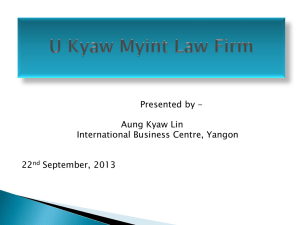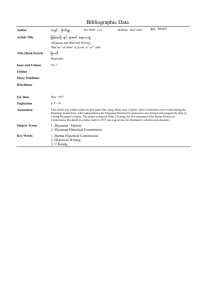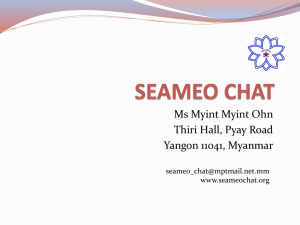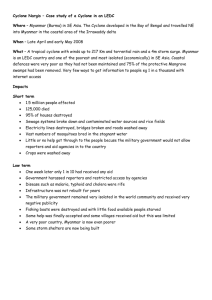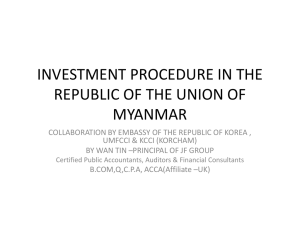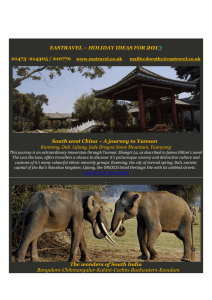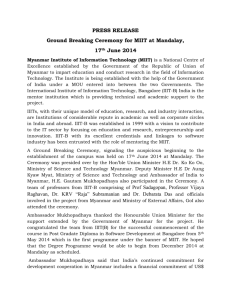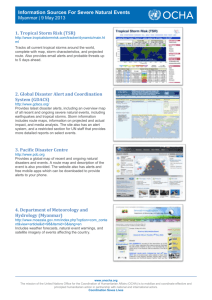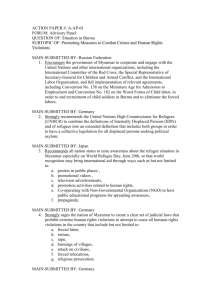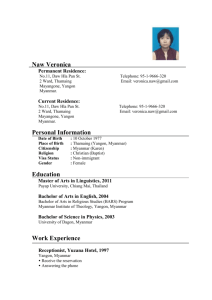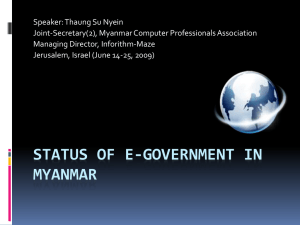NEW DEVELOPMENTS IN MYANMAR
advertisement
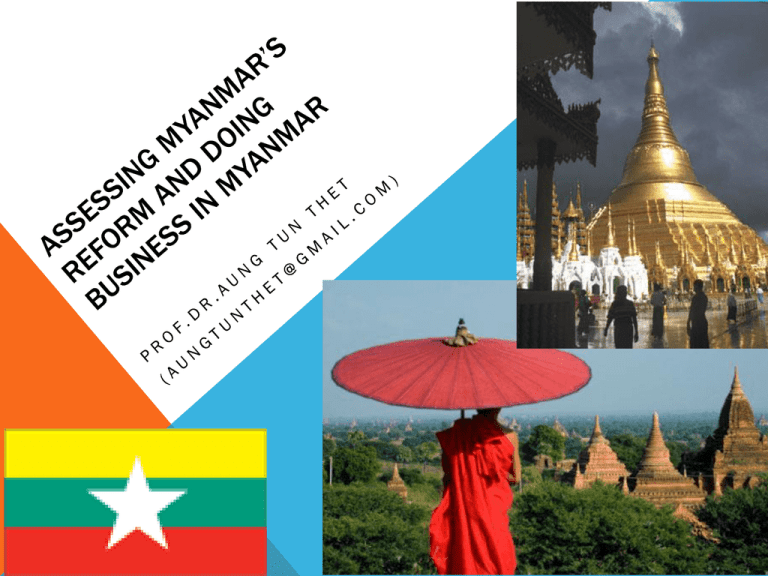
OVERVIEW 1. Part One: Assessing Myanmar’s Reforms 2. Part Two: Doing Business in Myanmar 2 3 • “All of us might wish at times that we lived in a more tranquil world, but we don't. • And if our times are difficult and perplexing, • so are they challenging and • filled with opportunities. “ 4 TODAY REALITIES • Very interesting and exciting • Volatile and Chaotic GEOGRAPHY • Strategic location • Between the two economic global powerhouses – China and India • Bridge between South and South East Asia DEMOGRAPHY Population 54,584,650 Age Structure 0-14 years: 27.5% 15-64 years: 67.5%) 65 years and over: 5% NEW WINDOW OF OPPORTUNITY • • • • Socio-economic progress Opportunities opening up Space growing ‘Latecomer’ 8 NATIONAL DEVELOPMENT STRATEGY • Ends – Poverty Reduction and Rural Development • Means – Good Governance and Clean Government • Eight-point Agenda 9 NATIONAL DEVELOPMENT STRATEGY • Goals • Reducing poverty from 26.5% to 16% by 2015 • Graduate from LDC • Three-fold increase in per capita GDP 10 ‘MYANMAR SPRING’ • Extraordinary, Unprecedented and Unimaginable! • President U Thein Sein • Rapid speed of recent changes • Peaceful revolution • Top-down ‘MYANMAR SPRING’ • On the brink of a momentous economic flowering • Most important period of political transition • Reconciliation and addressing long-neglected needs • Myit Sone Dam POLITICAL DEVELOPMENT • Release of political prisoners • Daw Aung San Suu Kyi and NLD in Parliament • Continued reconciliation between the Government and various ethnic groups • Myanmar Human Rights Commission PEACE DEALS Nine out of 16 rebel groups signed ceasefire agreements since August 2011 Deal reached with KNU Norwegian Peace Fund, Peace Centre LEGISLATIVE REFORMS • • • • • • • Dynamic leadership New laws enacted FDI Taxation Land Reform Freedom of Expression Freedom of Association LEGISLATIVE REFORMS • Engagement with 88 Generation • Willingness to Listen to the Voices of the People • ‘Check and Balance’ INTERNATIONAL RELATIONS • • • • • • • Rapprochement with the West High-profile visits of senior Government and National and UN officials Re-engagement with the international community Resumption of ODA Gradual lifting of Sanctions ASEAN Chairmanship in 2014 AFTA/AEC in 2015 INTERNATIONAL RELATIONS • • Engagement with UN UN Country Team Strategic Framework (2012-15) UNITED NTIONS ENGAGEMENT • Four Strategic Priorities 1. Encouraging inclusive growth in both rural and urban areas 2. Increasing equitable access to quality social services 3. Reducing vulnerability to natural disasters and climate change 4. Promoting good governance and strengthening democratic institutions and human rights 19 UNITED NTIONS ENGAGEMENT • • • • Social Protection Development Policy Options (DPOs) National Census (2013) UN Global Compact 20 SOCIO-ECONOMIC DEVELOPMENT • Priority to accelerate socio-economic development • Job Creation • Linkages between Peace , Democracy and Development • Guaranteeing Rule of Law • Promoting Civil Society • Media DEVELOPMENT PRIORITIES • • • • • Foreign exchange rate unification Agriculture Natural resources management Competitive business sector Financial/Banking Sector DEVELOPMENT PRIORITIES • • • • • Education and Health Legal structures Infrastructure, and Policy formation and implementation Millennium Development Goals (MDGs) 24 • “You can’t cross the sea, • merely by standing and staring at the water.” CHALLENGES • • • • Socio-economic and humanitarian challenges Weak capacity for implementing reforms Beginning not the end Much still depends on individuals not policy CHALLENGES • Sanctions • Official Development Assistance (ODA) • Lowest recipient of ODA among all LDC’s, with 7.2 US$ per capita in 2010 • FDIs CHALLENGES • Kick-Starting/Jump Start Growth – SEZs, Deep Sea Ports • Equality of opportunities not outcomes • “Pulled Along” by China, India + ASEAN • Poor Infrastructure • Corruption FROM CHANGE TO TRANSFORMATION MYANMAR IS OPEN FOR BUSINESS • “Faith is the bird that feels the light and sings, • when the dawn is still dark.” ‘NEW’ MYANMAR • • • • • One of Asia's final economic frontiers Comparative advantages Geographical location 60-million untapped market Bountiful natural resources INVESTMENT CLIMATE • New Foreign Investment Law • Western countries to become highest investing countries • Europe, Australia, Canada and USA cancelled the economic sanctions NEW MYANMAR INVESTMENT SUMMIT JUNE 2012 • Representative from USA, Germany, France, Canada, British, Italy, Norway, Australia , United Arab Emirates (UAE), China, Japan, Singapore, Thailand, Korea, Malaysia, Indonesia, Philippines, Vietnam, Cambodia, Mongolia, Lao, Sri Lanka and Bangladesh attended NEW FOREIGN INVESTMENT LAW (FIL) • Company which joint venture with foreign company 5 years free of tax and 70 years permission to do business INVESTMENT SITUATION: TOP 7 COUNTRIES COUNTRY US$ billion % 13.9 45.03 Hong Kong 6.3 20.37 South Korea 2.9 9.36 Thailand 2.5 7.99 UK 2.2 7.29 Singapore 1.5 4.83 France 0.5 1.62 China FOREIGN INVESTMENT Priorities 1. Resource-based investment 2. Resource-based export-oriented value added projects 3. Labour intensive export-oriented projects REASONS • • • Population approximately 60 million (approx. 5 million in Yangon) Vast and virtually untapped natural resources Relatively educated labour force and low wages REASONS • • • • Strategic location Sea and air links within the Asia region and beyond Generalized System of Preferences (GSP) 100% foreign-owned enterprises permitted REASONS • • • • Familiar business structures and commercial laws (based on the British law codes of the pre independence India Statutes ) English widely spoken and used Significant incentives under the Foreign Investment Law for larger investments Membership of ASEAN, BIMST-EC EXISTING CHALLENGES • International sanctions not fully removed yet • Opaque and arbitrary policymaking, including frequent, unannounced and unwritten policy changes EXISTING CHALLENGES Investments approved on a case-bycase basis • Weak rule of law and property rights • No independent judiciary and lack of legal transparency • Arbitrary tax policies • EXISTING CHALLENGES Tiny financial sector and shallow domestic capital market • Continued unpredictability in electricity supply, especially areas outside Yangon and other major cities • Privatization • EXISTING CHALLENGES • Weak educational system and unskilled work force • Poor infrastructure including communications and transportation networks • Evolving system of exchange rates and foreign exchange controls MYANMAR • Joined the UN Global Compact • Promoting Corporate Social Responsibility (CSR) • Encouraging Socially Responsible FDIs • Rotary International REVIEW 1. Part One: Assessing Myanmar’s Reforms 2. Part Two: Doing Business in Myanmar 49 • "Together we want to help the world see and believe, • in a better future." • There are those who look at things the way they are, • and ask why... • I dream of things that never were, • and ask why not?
